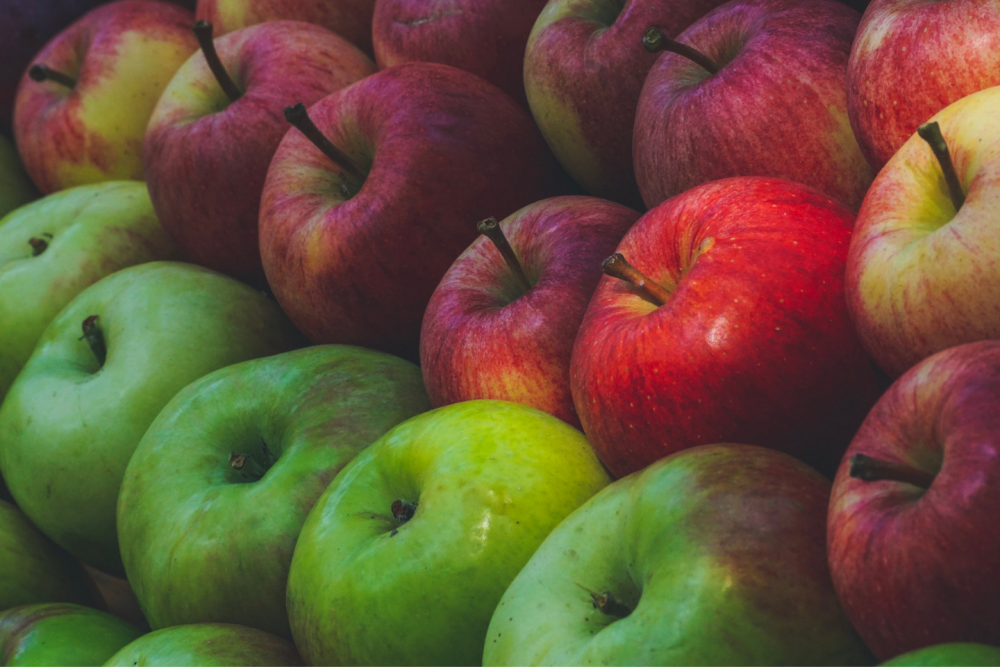
In this standards-aligned, 5-E life science lesson plan, students will learn that the goal of apple breeding is to continuously produce quality apples with desirable traits. Cross breeding and genetic engineering are two methods that have allowed breeders to produce better quality apples.
DetailsStudent Learning Targets
- Students will explore crossbreeding with a hands-on activity in which they will observe three apples.
- Students will record characteristic they notice in different varieties of apples.
- Students will use Punnett squares to predict the results of genetic crosses and determine the genotypes and phenotypes of apples in a particular cross.
Estimated Time
One 60-minute class period
DescriptionKey STEM Ideas
Genetics is the study of heredity, while heredity is the passing of traits from parents to offspring. This lesson will help solidify key genetics vocabulary words. The main idea of this lesson is to show the application of genetic crossing for the benefit of agriculture by producing apples with a variety of traits.
Gregor Mendel was a priest who worked with the genetic crossing of pea plants. He would cross purebred short pea plants with purebred tall pea plants. Through his experiments he determined that some traits were visible in the plant (dominant traits) while others were not, but were still able to be passed on future generations (recessive traits). Understanding what we see and what the genetic makeup of an organism is can be quite different. When you look at an organism its physical characteristics are all dependent on a specific allele combination. This is the difference between phenotype and genotype. Students will use Punnett Squares in this lesson to help determine all the possible allele combinations in a genetic cross and their probabilities.
Crossbreeding allows breeders to create better quality apples by incorporating traits from two parent plants into seeds of a new generation of plants. Breeders must understand both genotypes and phenotypes to accomplish this task. Breeders must also decide which traits are desirable and should be selected. This is an intensive process that involves breeding successive generations of apples with the preferred traits in order to get the final product.
Students' Prior Knowledge
Students should know that all cells of an organism have DNA. DNA is the blueprint providing the organism with coded instructions for proper function and development. Students should understand that genes are sections of DNA that are responsible for passing on traits from parent to offspring. Students will need to be familiar with vocabulary such as phenotype, genotype, homozygous, and heterozygous to successfully complete the student worksheet. Students will determine probabilities associated with possible offspring using Punnett Squares. Students will be introduced to varieties of apples. Students may have some knowledge associated with crossbreeding. This lesson will focus on crossbreeding apple varieties.
Connections to Agriculture
Apples are an important agricultural crop. There are about 7,500 apple producers in the United States. Washington, New York, and Michigan are the leaders in apple production. Growers produce a variety of different kinds of apples. Some apples are used for baking while others are used for eating. Apples are a good snack choice as they contain no fat and relatively few calories while being high in fiber and vitamin C.
Apples are grown through a process called grafting rather than being grown from seed. This is done because most apple varieties are self-unfruitful, which means their blossoms must be fertilized with the pollen of a separate variety in order to produce fruit. The fruit has traits from the parent tree, but the seeds inside will be a cross of the two varieties. This mixture of genetic material in the seeds means the grower won’t know what traits a tree grown from these seeds will have and what the resulting fruit will taste like.
To avoid this uncertainty, growers make a special cut on the rootstock of a tree. Then, they graft or transplant a section of a stem with leaf buds called a scion from a variety that has desirable traits into the cut. The two pieces will fuse together allowing for growth of the scion. Eventually, blossoms on the scion will be pollinated and will produce fruit with the desired traits. For more information and picture of the grafting process, please visit: http://articles.extension.org/pages/60602/apple-tree-propagation:-grafting
The goal of apple breeding is to continuously produce quality apples with desirable traits. Cross breeding and genetic engineering are two methods that have allowed breeders to produce better quality apples.
Curriculum ConnectionsNext Generation Science Standards
- MS-LS4-5. Gather and synthesize information about technologies that have changed the way humans influence the inheritance of desired traits in organisms
Common Core Standards
CCSS.ELA-Literacy.CCRA.R.7
- Integrate and evaluate content presented in diverse media and formats, including visually and quantitatively, as well as in words.
CCSS.Math.Content.7.SP.C.7
- Develop a probability model and use it to find probabilities of events. Compare probabilities from a model to observed frequencies; if the agreement is not good, explain possible sources of the discrepancy.
- Student Resources (Word Doc) (257.5 KB)
- Student Resources (PDF) (184.88 KB)
- Teacher Resources (Word Doc) (290.47 KB)
- Teacher Resources (PDF) (279.09 KB)
- Powerpoint Presentation (3.81 MB)